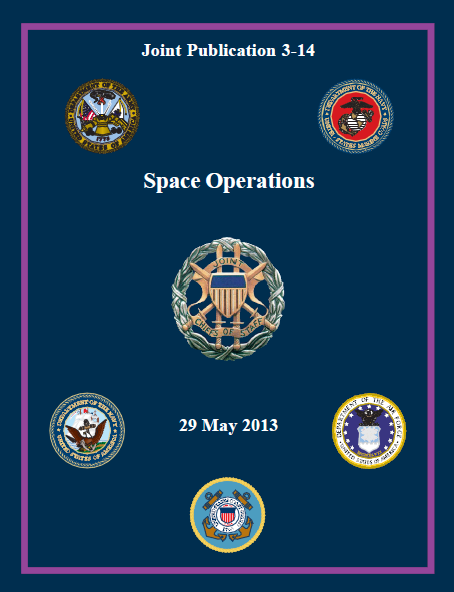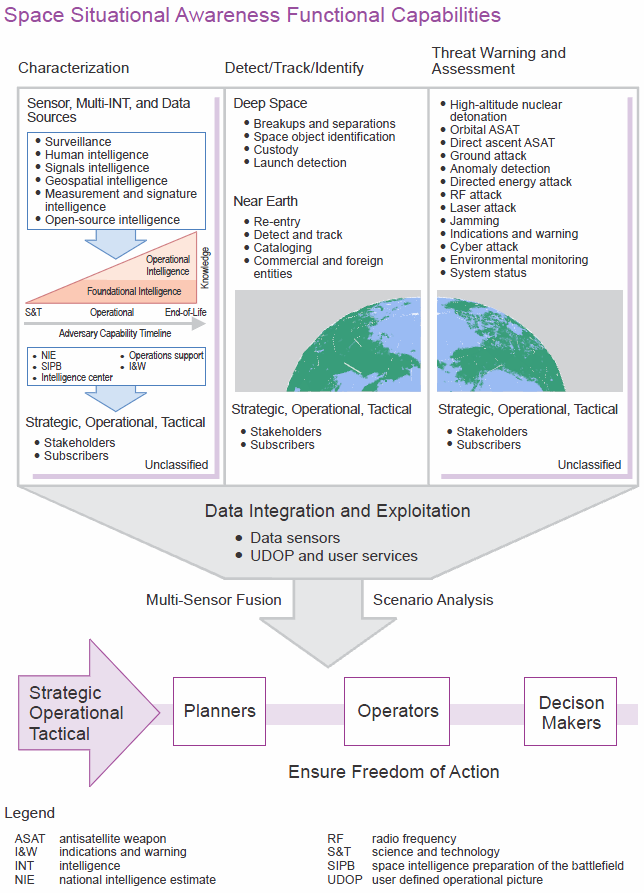Joint Publication 3-14 Space Operations
- 135 pages
- May 29, 2013
1. General
a. This publication provides guidance for planning, executing, and assessing joint space operations. It provides space doctrine fundamentals for all joint forces; describes the military operational principles associated with support from, through, and operating in space; explains Joint Staff, combatant command (CCMD), United States Strategic Command (USSTRATCOM), and USSTRATCOM functional and Service component relationships and responsibilities; and establishes a framework for the employment of space forces and space capabilities.
b. Space capabilities have proven to be significant force multipliers when integrated into military operations. Space capabilities provide global communications; positioning, navigation, and timing (PNT); services; environmental monitoring; space-based intelligence, surveillance, and reconnaissance (ISR); and warning services to combatant commanders (CCDRs), Services, and agencies. To facilitate effective integration, joint force commanders (JFCs) and their staffs should have a common and clear understanding of how space forces contribute to joint operations and how military space operations should be integrated with other military operations to achieve US national security objectives. To achieve optimal military utility from space, a basic understanding of space tools and the ability to coordinate activities between involved agencies and organizations and, when appropriate, integrate all necessary space capabilities with all other available capabilities (military, national, civil, commercial, and foreign) provides greater efficiencies and unified action. JFCs should establish a means to reasonably include appropriate outside agencies and organizations in operational planning, execution, and assessment activities.
c. US military use of space capabilities has changed significantly since military satellites were first placed in orbit. Continuous improvements in space technology have led to the development of more advanced space systems, as well as a host of commercially available capabilities. This has changed how commanders view space capabilities. Adversaries have also purchased and developed their own space capabilities. This has led to a situation where space is a congested, contested, and competitive environment.
(1) Vulnerability
(a) Military, civil, and commercial sectors of the US are increasingly dependent on space capabilities, and this dependence is a potential vulnerability as space becomes increasingly congested, contested, and competitive. Purposeful interference (PI) consists of deliberate actions taken to deny or disrupt a space system, service, or capability. PI with US space systems, including their supporting infrastructure, will be considered an infringement of US rights. Such interference, or interference with other space systems upon which the US relies, is irresponsible in peacetime and may be escalatory during a crisis. When practical and authorized, the joint force will protect civil, commercial, and foreign space capabilities.
(b) Commanders should consider the possibility of hostile actions from state and non-state actors intended to deny friendly forces access to, or use of, space capabilities while developing strategic estimates, plans, and other documents and planning future operations and activities. They also should anticipate the proliferation and increasing sophistication of space capabilities and products with military utility that could be used by any adversary for hostile purposes. Potential adversaries no longer have to develop large infrastructures to obtain or interfere with space capabilities. Today, many capabilities can be easily purchased. Options available to exert influence or prevent an adversary’s access to space capabilities include diplomatic, informational, military, and economic measures.
(2) Freedom of Action. US forces should have the freedom to take advantage of the capabilities provided by space systems at a given time and place without prohibitive interference by the opposing force.
(3) Protection. Commanders should protect critical space systems and supporting infrastructure and take steps to assure availability of space-enabled mission-essential functions by developing techniques, measures, and relationships to maintain continuity of services.
(4) Global Reach and Responsiveness. Space-based capabilities are unique in that they are not subject to traditional air overflight restrictions and may already be in position to support operations when crises arise. However, there may be instances when the rapid surge of a capability, or the expeditious replacement of a capability, is required. In those cases, commanders should be aware that increasing capabilities of deployed spacebased systems may be accomplished in hours to days, while development and deployment of replacement capabilities could take a year or more.
(5) Space Deterrence. Joint force operations contribute to the nation’s multilayer approach toward deterring aggression against our space capabilities and infrastructure by:
(a) Promoting and demonstrating responsible behavior when employing space capabilities;
(b) Pursuing partnerships that encourage restraint in potential adversaries;
(c) Contributing to quick attribution for attacks;
(d) Protecting our space capabilities and infrastructures; and
(e) Implementing appropriate responses should deterrence fail.
d. Space systems provide specialized capabilities and offer global force enhancements critical to mission success. To realize the global advantage provided by space capabilities, JFCs must collaborate with USSTRATCOM and national agencies to ascertain military utility, vulnerabilities, and availability of space-enabled capabilities to achieve best efficiency and effectiveness.
…



